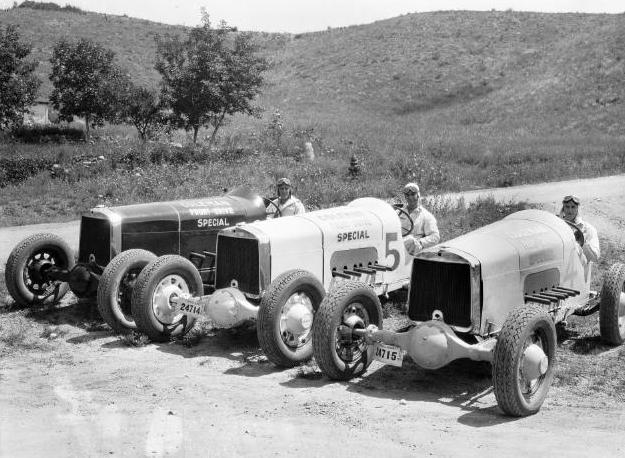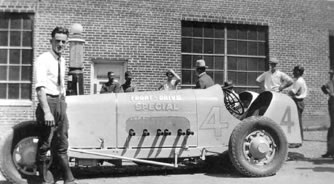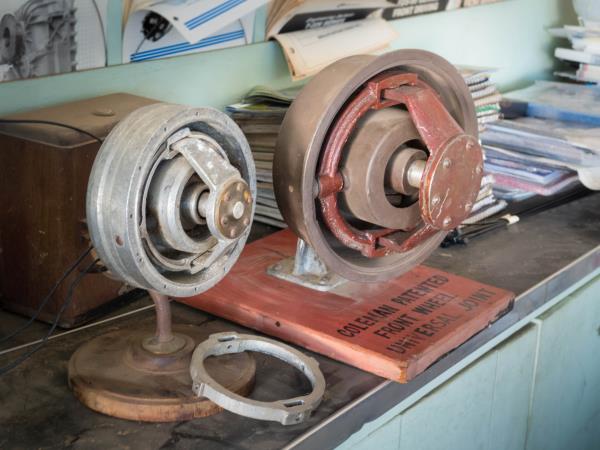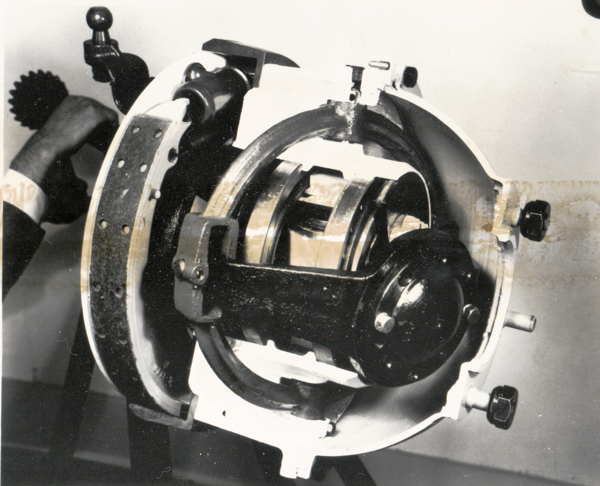Coleman Special Indianapolis Cars - 1930s
#1

Posted 28 January 2020 - 01:22
Information on these cars seems very hard to come by, both on the internet and in contemporary publications. So far, I have only gathered the following:
Apparently as a preliminary to the Indy entries, the company built three cars for the Pikes Peak hill climb event in 1929, and these were driven by three Unsers of that generation, so this was no half-hearted PR exercise. Coleman clearly meant business, and they got results, finishing 2nd, 5th and 6th.
A few pictures are available on the internet, but nothing more. They show a rather interesting layout. The six-cylinder engine is set well back from the radiator, so far that the driver sits over the rear axle, leading to a weight distribution that seems as poor as it can possibly be, for a front-drive car, more so when going uphill. This does not seem to have hindered them, but it was corrected on the Indy cars the following year, with a more nearly normal layout, for a front-drive car.
The other extraordinary feature, clearly seen in the pictures, is that the live front axle is directly secured to the forward ends of the two frame rails, no suspension of any kind being evident. Since the road up Pikes Peak was not surfaced in any way, the ride could not have been very comfortable. On the other hand, many cars of that era were reputed to have more flexibility in their frames than in the springs, so perhaps it was not much worse than it might have been.
1930: Two cars entered, each fitted with a Miller 4-cylinder 183ci engine. Both qualified, and one finished 7th, a fine performance by a newcomer.
A handful of pictures is to be found on the internet, from which it is clear that front-wheel-drive is used, but not of the then standard Miller pattern (which was a de Dion axle, suspended by twin quarter-elliptic leaf springs each side). Instead, a live axle is employed, with a half-elliptic spring each side, improbable though that may sound. The differential casing upper half fits rather neatly into a semi-circular cut-out at the base of the radiator shell, so perhaps suspension movement was even less than was common at the time.
Guesses/deductions: It seems probable that the gearbox was behind the differential, just ahead of the engine, flywheel and clutch (not, as in the Millers, to one side of the differential, and in the same casing). But it is not clear if all these units were rigidly attached to one another; if they were, then all of them, in varying degrees, would count as unsprung weight. It is, also, just possible that a single universal joint was interposed between clutch and gearbox, to allow a modicum of suspension movement, and also to reduce unsprung weight.
The front end of the frame looks rather like that of a rear-drive Miller of the same era, but I have been unable to ascertain who the builder was, or anything else about it. The radiator shell, however, closely resembles that of some Millers of a year or two earlier.
1931: One car entered, fitted with two Miller 4-cylinder 183ci engines, hence at the limit of the allowed capacity. Possibly the most powerful car in the race, and probably very hard to control, for both engines drove the front wheels, again. It qualified at about 108mph (pole speed 112.8mph) but was withdrawn because of clutch trouble, perhaps not surprisingly. However, it is unknown whether one clutch served both engines, or each had its own clutch. As far as starting is concerned, the latter seems more probable.
No picture of this car seems to be available on the internet, or anywhere else that I can find, so no visual clues as to how all that machinery was arranged. One preview of the race says that those engines were side by side, each driving a central gear through a pinion on its crankshaft. Such an installation is not so simple as it may sound.
Guesses/deductions: If “handed” cylinder heads could be bought or made, then all the carburettors could be arranged on the inner sides, between the two cylinder-heads, and all the exhausts would be conveniently on the outer sides. If not, the engines would need to be rather widely separated, so that the exhaust pipes of one were well clear of the carburettors of the other. Alternatively, each engine could be inclined a few degrees outward, again creating more space between. But routing of that pipe in between would be problematic, possibly creating a hot spot in the cockpit.
All that power may have affected other things besides the clutch(es). Gearbox and tyres come to mind, to say nothing of high fuel consumption and heavy steering.
1932: One car entered, fitted again with two Miller 4-cylinder 183ci engines, and with four-wheel-drive, probably as the result of the previous years’ experience. Possibly a developed/modified version of the 1931 car. The car was wrecked in a practice crash, and apparently no more was heard of it. However, it does share, with the Bugatti T53 and the Miller FWD, the distinction of being the first four-wheel-drive racing car.
Two pictures, one a head-on view, are to be found on the internet, as well as in at least one book, with no caption or explanatory notes. About the only thing that can be seen is that the body was unusually wide at the front end, which would fit with the deductions above (1931). And apparently the live front axle was still in use.
Guesses/deductions: No information about the arrangement of the transmission or the suspension, nor about the method of simultaneous control of the two engines. More than likely, this consisted of a single, rocking throttle pedal, as later employed by other twin-engine cars, including Bloody Mary and Fuzzi.
Can anyone add comments/opinions/information/pictures to this? Look forward to any contributions.
Advertisement
#2

Posted 28 January 2020 - 03:26
https://www.oldracin...m/indy/coleman/
#3

Posted 28 January 2020 - 06:04
Coleman use a rather unique universal joint system, it is well worth looking up.
#4

Posted 28 January 2020 - 08:14
Do you have a link for that, Michael?
I'd certainly like to see it...
#5

Posted 28 January 2020 - 08:34
Apparently as a preliminary to the Indy entries, the company built three cars for the Pikes Peak hill climb event in 1929, and these were driven by three Unsers of that generation, so this was no half-hearted PR exercise. Coleman clearly meant business, and they got results, finishing 2nd, 5th and 6th.
Keen as mustard.
#6

Posted 28 January 2020 - 09:31
It's been a while since I last studied these cars, but I well recall that there was no universal joint in the driveline, and the whole engine/transmission job swiveled in its yoke! A truly adventurous design!!
About the twin engines, there were no cylinder heads to be changed or made, since the Millers had block castings with integral heads. However, the overall layout was such that the whole block could be turned around on the crankcase, and the gear train attached to the other side with minimal effort.
Unfortunately, I don't recall any extensive write ups about the transmission, so your guess is as good as mine. ![]()
#7

Posted 29 January 2020 - 10:07
The Coleman does have a universal joint, it sits around the outside of the front hub. That's why the front wheels have a big dome.
#8

Posted 29 January 2020 - 10:45
I'm not sure that's true for the Indy car. As far as I recall, it had pretty normal wheels with brake drums, that's all. Unfortunately, the computer here at work is shite, and a picture hunt on the internet is too much to ask from this poor little processor, so I can't check until I get home.
#9

Posted 29 January 2020 - 16:41
Trying to think first for a change, I now realize that the car would have needed universal joints at the wheels to enable steering, of course. What I meant in my earlier post was, that there was no universal joint in the driveline to allow for suspension travel - the whole engine/transmission unit moved up and down as a unit, or at least that's how I understood it to have worked.
#10

Posted 30 January 2020 - 08:21
Coleman's main business was building four wheel drive conversions for trucks and light trucks, they knew how to make a front drive axle that could steer.
This was the three cars that were built for Pikes Peak, you will notice that the front axles look fixed and unable to steer but this is how Coleman axles looked...
Another shot with a man thoughtfully blocking the view of the front axle but you can clearly see the conventional steering drag link going to the front axle...
#11

Posted 30 January 2020 - 08:52


Exploded parts view...

Edited by Catalina Park, 30 January 2020 - 08:56.
#12

Posted 30 January 2020 - 09:59
Thanks, Michael...
It is a different way of doing things.















